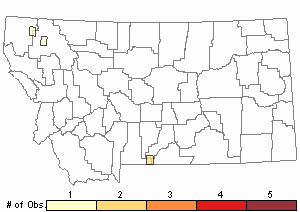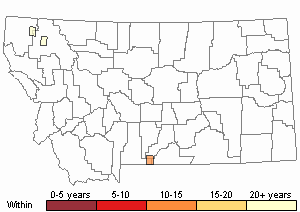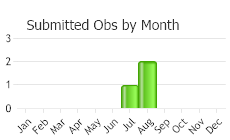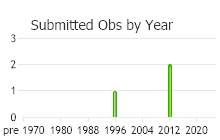View in other NatureServe Network Field Guides
NatureServe
Montana
Utah
Wyoming
Idaho
Wisconsin
British Columbia
South Carolina
Yukon
California
New York
Meesia Moss - Meesia longiseta
General Description
Plant: Scattered or tufted. Dark green to yellow-green, often blackish below. Stems 4-7 cm tall, simple, but occasionally a little branched. Rhizoids papillose.
Leaf: When dry, leaves somewhat contorted. When moist, leaves spread. Leaves 2-5 mm long, ovate-lanceolate, acute to obtuse, and somewhat decurrent. Margins plane to slightly recurved and mostly entire. Costa ends before the apex or almost percurrent, narrow (about 1/5 width of leaf at base).
Leaf Cells: Upper and median leaf cells are rectangular to irregular, 12-15 µm wide. In X-S, cells are mostly uniform and walls are a little thick. Cells of leaf are large and easy to see with hand lens.
Diagnostic Characteristics
M. longiseta is synoicous whereas the similar M. triquetra is dioicous (FNA 2014).
Range Comments
From Greenland to Alaska and south to Alberta and Manitoba. Known in eastern North
Canada: AB, BC, MB, NL, NT, NU, ON, YT; USA: AK, CA, CT, ID, IN, NH, NY; Central America; n Eurasia (FNA 2014). In Montana, known from Flathead County (Elliott 2016).
Notes from previous records: America from a few scattered locations in Ontario, Maine, Ohio, and Illinois, and reported from Idaho (historical), Montana, and the Northwest Territories. Known from northern and central Europe and Siberia (Crum and Anderson 1981). New Brunswick, Massachusetts, and New York (Howard 1975). Scattered in Fennoscandia, where recorded from 8 provinces each in Sweden and Norway, 7 provinces in Finland, and 1 province in Denmark (Nyholm 1954-69).
Observations in Montana Natural Heritage Program Database
Number of Observations: 4
(Click on the following maps and charts to see full sized version)
Map Help and Descriptions
Relative Density

Recency



 (Observations spanning multiple months or years are excluded from time charts)
(Observations spanning multiple months or years are excluded from time charts)
Habitat
Wet soil and humus in bogs and fens (Elliott 2016).
Reproductive Characteristics
Synoicous. Seta is up to 9+ cm long. Capsules are 3-5 mm long (with neck).
Stewardship Responsibility
References
- Literature Cited AboveLegend:
 View Online Publication
View Online Publication Crum, H.A. and L.E. Anderson. 1981. Mosses of Eastern North America. 2 volumes. Columbia University Press, New York. 1328 pp.
Crum, H.A. and L.E. Anderson. 1981. Mosses of Eastern North America. 2 volumes. Columbia University Press, New York. 1328 pp. Elliott, J.C. and A.K. Pipp. 2018. A Checklist of Montana Mosses (1880-2018). Updated 3 January, 2020. Montana Natural Heritage Program, Helena, Montana. 73 pp.
Elliott, J.C. and A.K. Pipp. 2018. A Checklist of Montana Mosses (1880-2018). Updated 3 January, 2020. Montana Natural Heritage Program, Helena, Montana. 73 pp. Flora of North America Editorial Committee, eds. 2014. Flora of North America North of Mexico. Volume 28. Bryophytes: Mosses, Part 2. Oxford University Press, Inc., NY. xxi + 702 pp.
Flora of North America Editorial Committee, eds. 2014. Flora of North America North of Mexico. Volume 28. Bryophytes: Mosses, Part 2. Oxford University Press, Inc., NY. xxi + 702 pp. Howard, Lauren Davis. 1975. Moss Flora of New England, New York, and Southeastern Canada. The University of Vermont, Burlington, Vermont. 74 p.
Howard, Lauren Davis. 1975. Moss Flora of New England, New York, and Southeastern Canada. The University of Vermont, Burlington, Vermont. 74 p. Nyholm, E. 1954-69. Illustrated Moss Flora of Fennoscandia. II. Musci. Fascicles1- 4. Gleerups, Lund; Fascicles 5-6, Swedish Natural Science Research Council, Stockholm.
Nyholm, E. 1954-69. Illustrated Moss Flora of Fennoscandia. II. Musci. Fascicles1- 4. Gleerups, Lund; Fascicles 5-6, Swedish Natural Science Research Council, Stockholm.
- Additional ReferencesLegend:
 View Online Publication
View Online Publication
Do you know of a citation we're missing? Elliot, J. C. 1993. Second checklist of Montana mosses. Unpublished report. U.S. Forest Service, Region 1. Missoula, MT. 45 pp.
Elliot, J. C. 1993. Second checklist of Montana mosses. Unpublished report. U.S. Forest Service, Region 1. Missoula, MT. 45 pp. Lawton, E. 1971. Keys for the Identification of the Mosses on the Pacific Northwest. Reprinted from 'Moss Flora of the Pacific Northwest'. Published as Supplement No. 2 of the Journal of the Hattori Botanical Laboratory. Nichinan, Miyazaki, Japan. 66 pp.
Lawton, E. 1971. Keys for the Identification of the Mosses on the Pacific Northwest. Reprinted from 'Moss Flora of the Pacific Northwest'. Published as Supplement No. 2 of the Journal of the Hattori Botanical Laboratory. Nichinan, Miyazaki, Japan. 66 pp. Lawton, E. 1971. Moss Flora of the Pacific Northwest. Hattori Botanical Laboratory. Japan: Yamabuki-cho, Shinjuku-ku, Tokyo. 362 pages plus appendices.
Lawton, E. 1971. Moss Flora of the Pacific Northwest. Hattori Botanical Laboratory. Japan: Yamabuki-cho, Shinjuku-ku, Tokyo. 362 pages plus appendices.
- Web Search Engines for Articles on "Meesia Moss"





